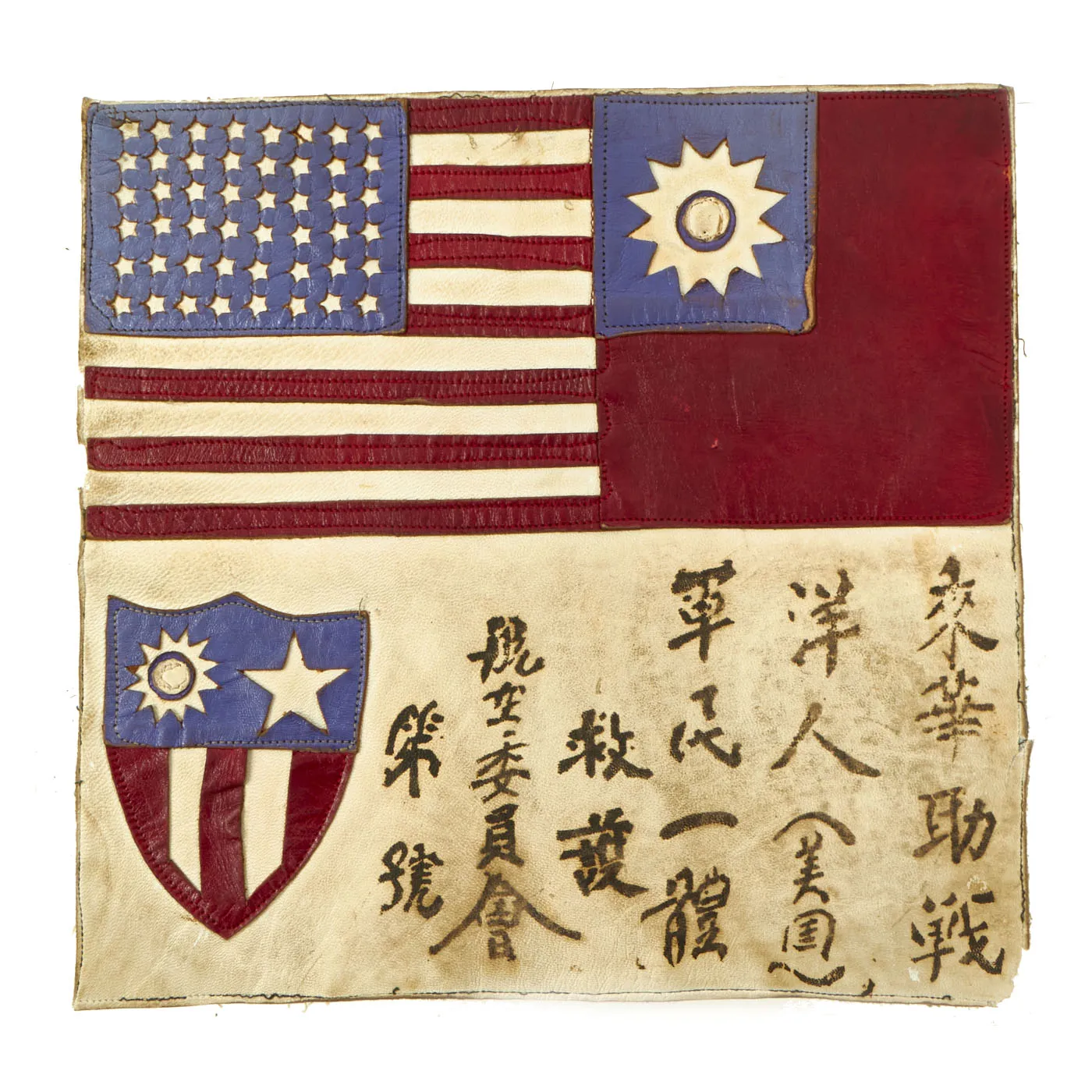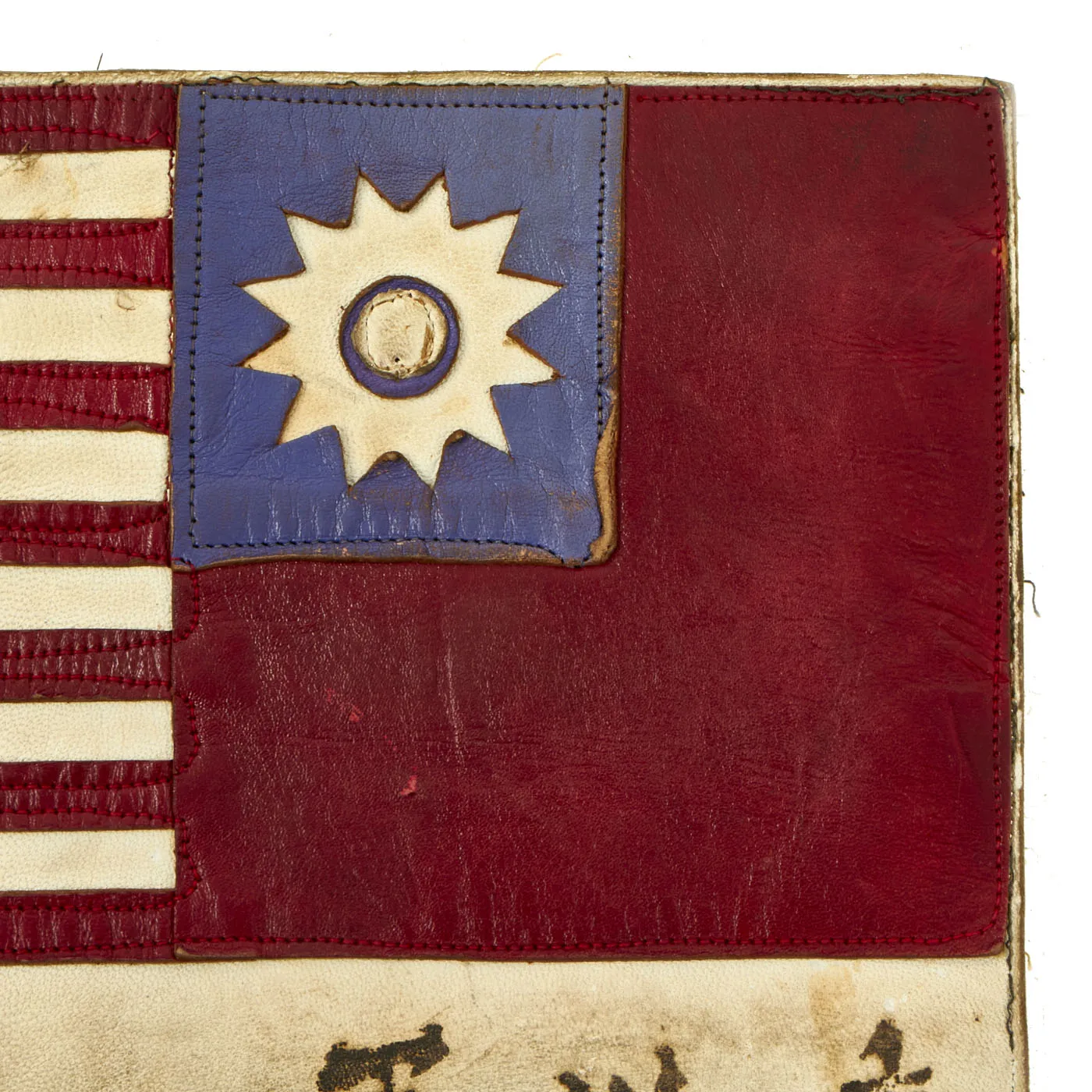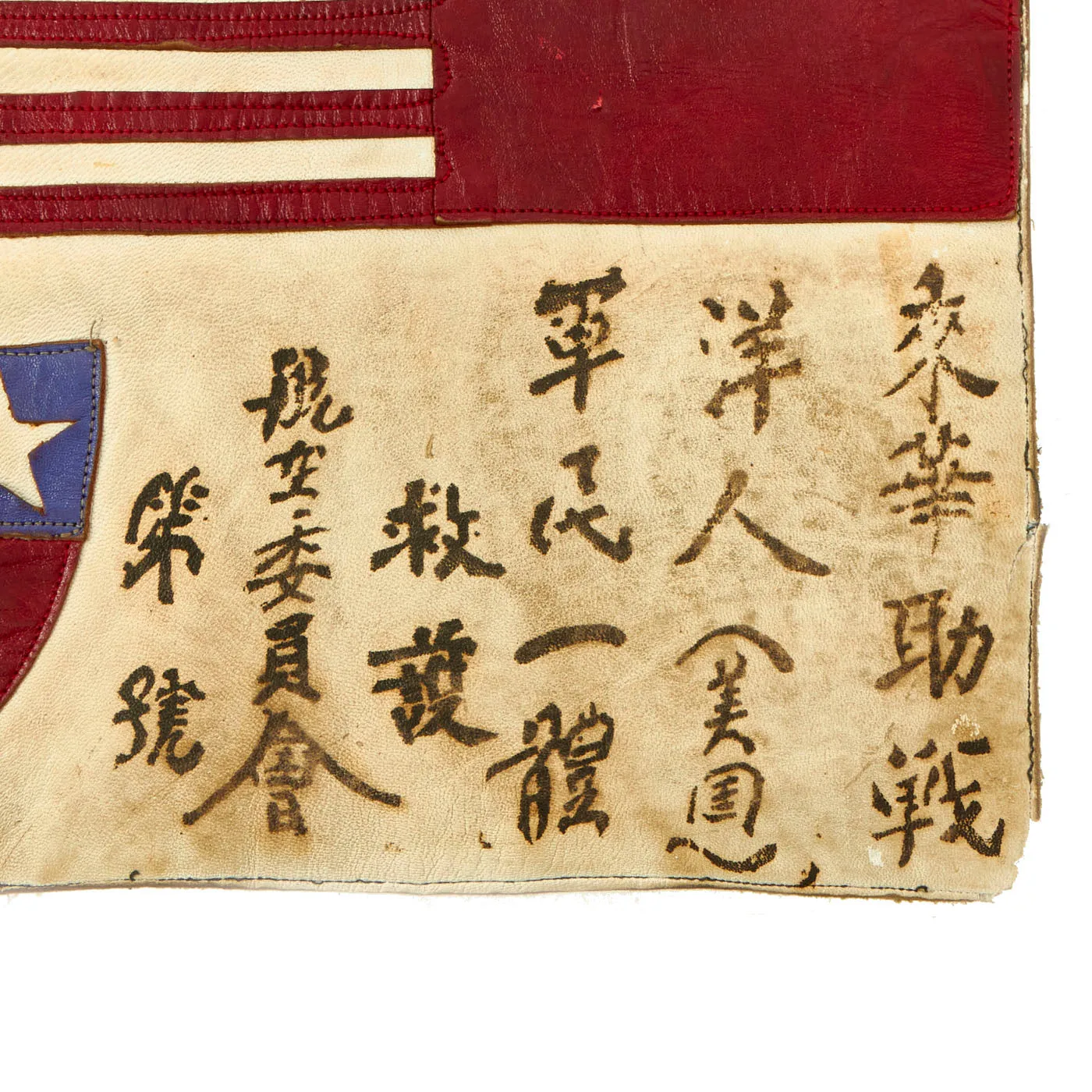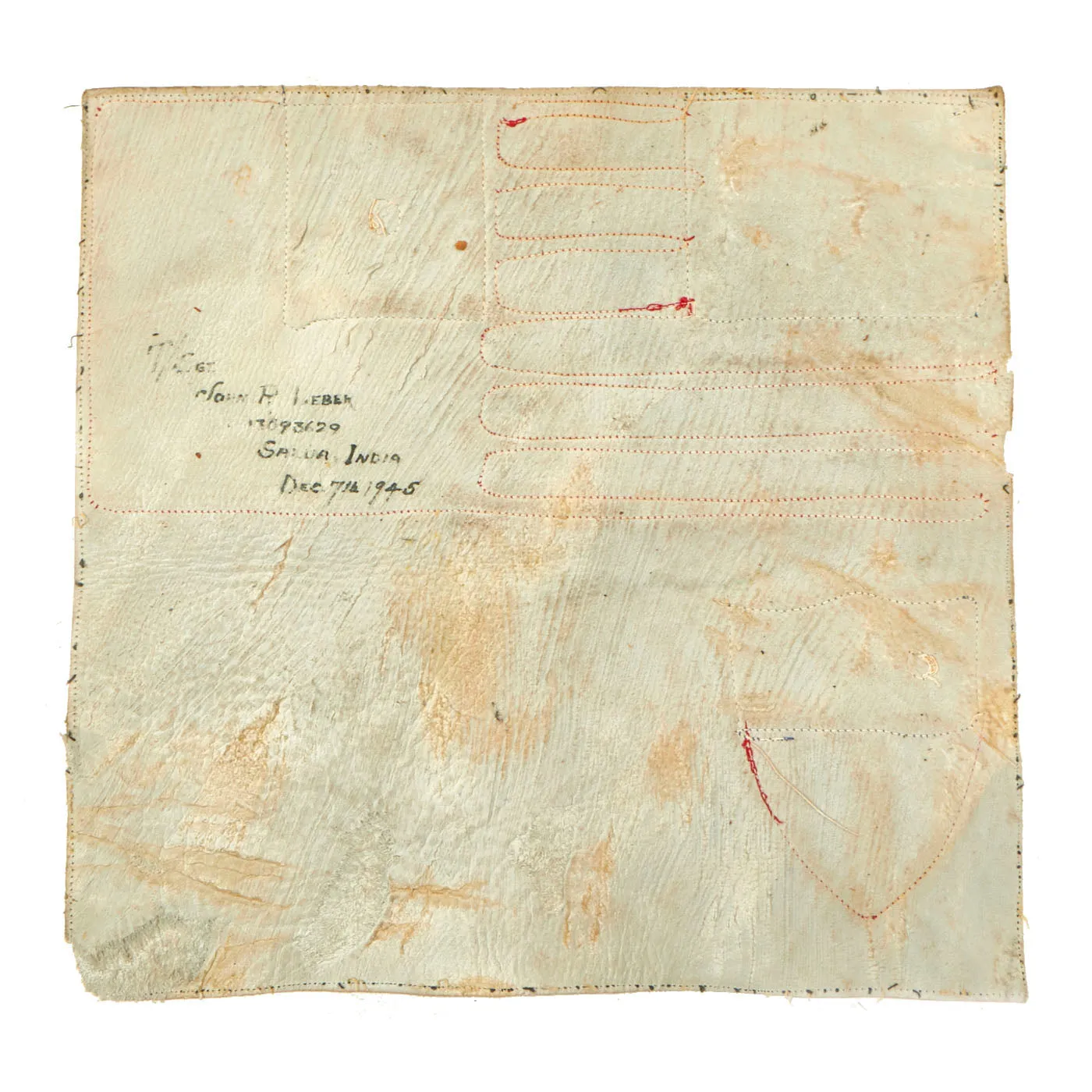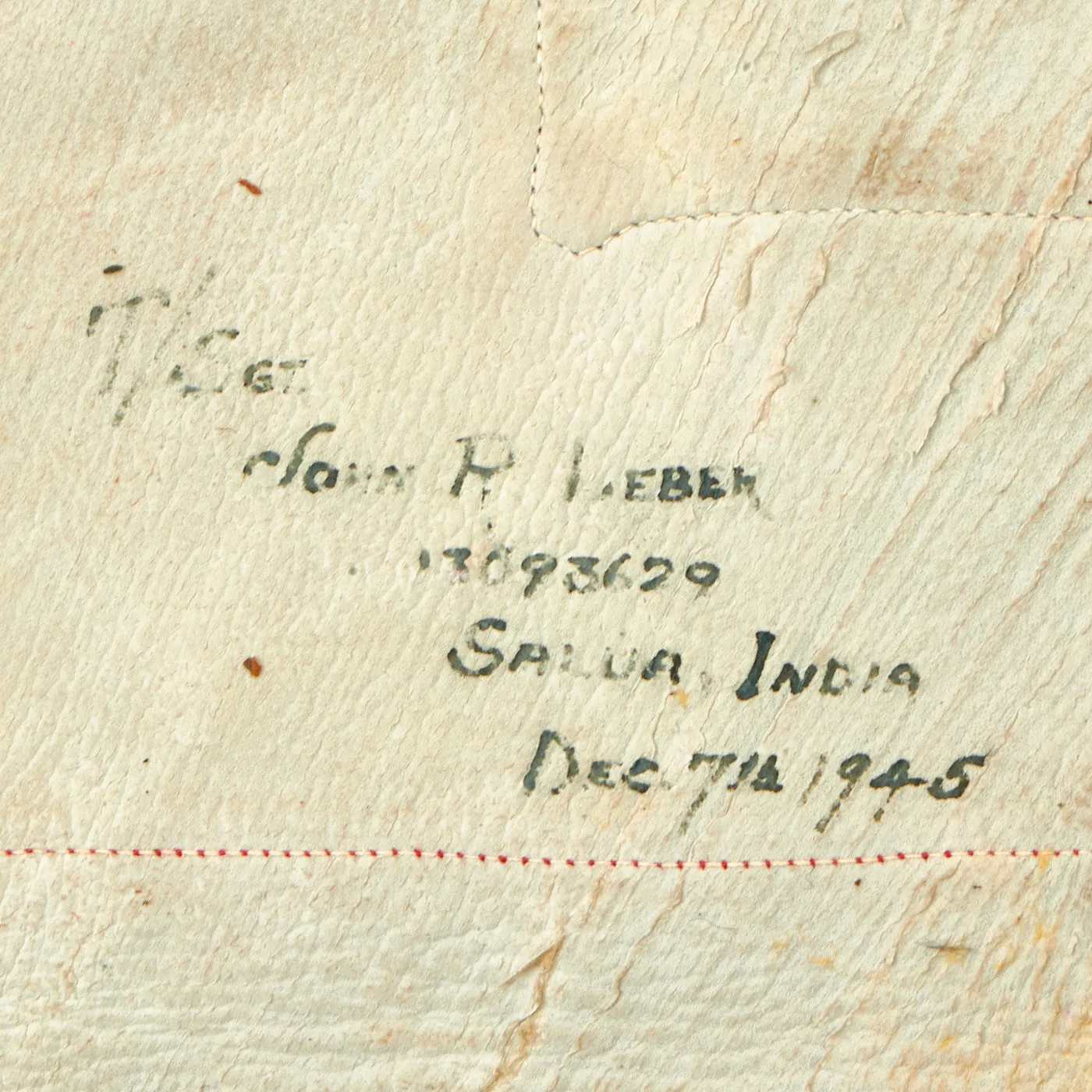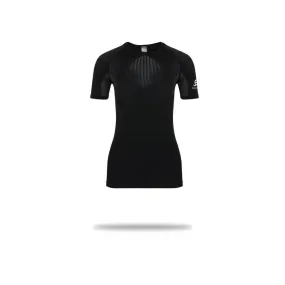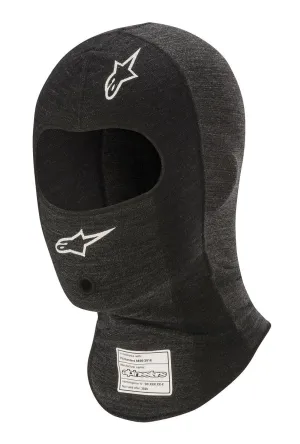Original Item: Only One Available. This is an excellent example of a WWII leather blood chit which is actually named on the reverse, something seldom seen. The blood chit is in fantastic condition and shows evidence of having been sewn into the lining of an A2 flight jacket, as does the patch. The leather chit features an American flag to the left of the Chinese National flag with Chinese Characters at the bottom to the right of a leather CBI shield. The chit measures approximately 9 ½” by 10".
A blood chit is a notice carried by military personnel and addressed to any civilians who may come across an armed-services member – such as a shot-down pilot – in difficulties. As well as identifying the force to which the bearer belongs as friendly, the notice displays a message requesting that the service member be rendered every assistance.
The reverse has a name and possible mission date written on the top left corner:
T/Sgt John R. Leber
13093629
SALUA, INDIA
DEC. 7TH, 1945
T/Sgt John R. Leber enlisted on October 18, 1942 and trained as an Aircraft Mechanic, soon becoming a Crew Chief, flying on Curtiss C-46 Commandos and Douglas C-47 Skytrains in the Chinese-Burma-India Theater of War during WWII, making multiple death defying trips over the infamous “The Hump”. The Hump was the name given by Allied pilots in the Second World War to the eastern end of the Himalayan Mountains over which they flew military transport aircraft from India to China to resupply the Chinese war effort of Chiang Kai-shek and the units of the United States Army Air Forces (USAAF) based in China. Creating an airlift presented the USAAF a considerable challenge in 1942: it had no units trained or equipped for moving cargo, and no airfields existed in the China Burma India Theater (CBI) for basing the large number of transports that would be needed. Flying over the Himalayas was extremely dangerous and made more difficult by a lack of reliable charts, an absence of radio navigation aids, and a dearth of information about the weather.
Leber served honorably until his discharge on March 17, 1946. Luckily there is a “Oral History” interview present at this link: . Unfortunately, full access is only allowed to those that are members of the University of North Texas, making for a wonderful networking and research opportunity. There is a brief summary on what the interview consists of though:
“His experiences in the China-Burma-India Theater during World War II. Stateside training in California, Nebraska, and Texas; description of trip in C-46 from Savannah to Labrador, to New Foundland, to Greenland, to Iceland, to Scotland, to southern France, to Egypt, to Saudi Arabia, to Karachi; descriptions of local culture as part of "The Great Adventure"; assignment to Ledo, Burma, and evacuation of troops and supplies after the war; his feelings about the dropping of the atomic bomb; contraction of dysentery and hospitalization in Kunming, China; flying "The Hump"; everyday camp life at Ledo; short assignment to Hsian, China, and Salua, India; sightseeing in Calcutta and observations of local culture and customs; the trip home to the U. S. by way of Manila and across the Pacific to San Francisco; postwar adjustments to civilian life.”
This is a fantastic piece of CBI history, named to a crewman who made multiple flights over “The Hump”! Comes more than ready for further research and display.
317th Troop Carrier Squadron
The 317th was first activated as a transport squadron during World War II and airlifted cargo and mail for the Eighth Air Force within the United Kingdom from 1943 to 1944.
The squadron's second activation was as a troop carrier unit. After training in the United States, it moved overseas and airlifted troops and cargo in India and Burma from 11 November 1944 to about August 1945. Through its first eight months in theater, the squadron flew Chinese troops, horses, and mules over The Hump, air dropped supplies, and evacuated wounded. The squadron arrived in theater at a time when British troops were on the offensive in the Chindwin Valley. Because only a few forward airfields were available, a large amount of supplies for these troops had to be airdropped to them. The squadron also airlanded at the forward airfields and evacuated wounded aiding the ground troops in the successful outcome of the campaign.
In December 1944, a decision was made to airlift an entire Chinese division and all of its equipment over The Hump to respond to the Japanese capture of Kweilin, which threatened the lifeline to China. The 317th, along with other transport squadrons, spent most of its efforts until 6 January 1945 in supporting this operation, for which it received commendations from the commanding generals of Army Air Forces, India Burma Theater and Tenth Air Force.
The squadron then turned its efforts toward Burma, while its glider section trained British glider pilots. In February, planning was made for glider operations from Sinthe to seize airfields in the Meiktila area. However, British forces seized the airstrip at Thabutkon and after one of the squadron's gliders had landed to inspect the field the squadron began operations to airlift an Indian brigade into the field. For this assault landing the squadron was awarded an arrowhead for its campaign ribbon. In April, the squadron glider section landed eight gliders loaded with engineering equipment into the Lewe airfield to level the field for aircraft operation. An attack the following day by Nakajima Ki-43 "Oscar" fighters resulted in the destruction of five of the gliders. This operation earned the squadron a second arrowhead.
In May 1945, British and Indian forces had driven forward and were closing in on Rangoon. It was determined to conduct an airborne assault to the south of Rangoon to capture or destroy Japanese gun positions. The 317th dropped Gurkha paratroopers at Elephant Point in the first combat airdrop in Asia. The squadron converted from a commando unit in September and provided aerial transportation for US and allied units in China briefly after the war until November 1945.

